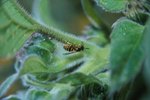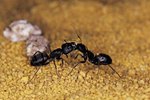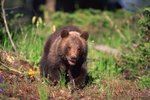
Insects use color for a variety of reasons. Some use it to blend in with their surroundings to avoid detection, others use it to signal their presence from afar. Would-be predators typically associate bright color and contrasting patterns with danger and learn to avoid such animals. Yellow and black stripes are a common example of this sort of warning coloration.
Bumble Bee
Bumble bee coloration is iconic. Even taken out of context, the yellow body and black stripes quickly bring to mind the humble bumble bee. Bumble bees have a sting and they also taste pretty nasty, so their contrasting stripes serve as a warning to avian predators. The coloration of the bumble bee serves to protect both the insect and the predator. It is nature’s way of saying “don’t even bother.”
Wasps and Hornets
Similar to bumble bees, some wasps have evolved to carry a warning to predators that attempting to eat them would be folly. Not all wasps have stings, but those that do have the brightest patterns. Non-stinging wasps are typically duller in color and have fewer, if any, stripes. Their means of avoiding predation is to blend in, while their striped, stinging cousins, like the hornet and the yellow jacket, do the opposite.
Hoverfly
While bees and wasps evolved to have a sting, the hoverfly evolved to simply look like it has one. These fruit-eating flies are perfectly harmless and have no sting, but they carry all the warning signs of an insect that does. For this reason, predators avoid hoverflies just as they would avoid bees and wasps.
Cucumber Beetle
The tropical cucumber beetle bears a striking yellow and black pattern. Although ants pose a threat to the unhatched eggs of the cucumber beetle, once this insect reaches adulthood, it is relatively unharassed by predators.
Cinnabar Moth Caterpillar
The cinnabar moth caterpillar displays the classic black-on-yellow striped coloration. These stripes are a warning to any creature thinking about eating the caterpillar that they should really find another meal. While this caterpillar is not particularly toxic, it feeds on poisonous ragwart leaves, making it highly distasteful. When the caterpillar becomes a cinnabar moth, it loses its color.
Wasp Beetle
The harmless wasp beetle not only mimics the color and appearance of the wasp, it also mimics its movement, by jerking from side to side. This makes it appear to predators as if it were a wasp and ensures that he can feast on flowers and hedgerows in peace.
References
- North Carolina State University: Insect Defenses
- MTV: Blind Melon 'Bee Girl' Grows Up, Has Eye On Acting Career
- J Stor: The Evolutionary Significance of Bumble Bee Color Patterns; A Mimetic Interpretation
- National Geographic: Wasp
- University of Florida; Entomology and Nematology: Yellowjackets and Hornets
- Royal Society for the Protection of Birds: Hoverfly
- University of Florida; Entomology and Nematology: Banded Cucumber Beetle
- UK Moths: The Cinnabar
- Norfolk Wildlife Trust: Cinnabar Moth
- Wildlife Trusts: Wasp Beetle
Photo Credits
-
Ablestock.com/AbleStock.com/Getty Images
Writer Bio
Simon Foden has been a freelance writer and editor since 1999. He began his writing career after graduating with a Bachelors of Arts degree in music from Salford University. He has contributed to and written for various magazines including "K9 Magazine" and "Pet Friendly Magazine." He has also written for Dogmagazine.net.




